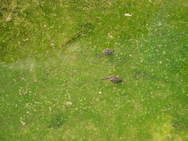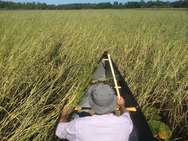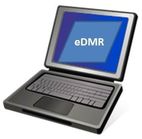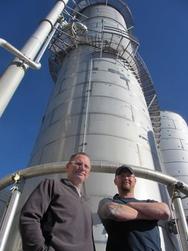|
July 2016

The Kasson wastewater treatment plant (WWTP)
is upgrading to accept wastewater from the neighboring city of Mantorville in
southern Minnesota. The Minnesota Technical Assistance Program (MnTAP)
was enlisted to estimate the electrical conservation.
From mid-November through December 2015,
MnTAP analyzed the electrical conservation potential of the Kasson WWTP and identified
three opportunities to reduce operating costs:
- Dissolved oxygen control could save $13,000/year
and 147,000 kilowatt hours (kWh, a measurement of electricity used): Kasson
uses two secondary aeration oxidation ditches to break down organics. The
oxidation ditches currently run near the minimum speed allowed by SCADA
programming and are manually adjusted. The current electrical cost for
secondary aeration is $36,300 per year. Current programming does not allow
operation across the full design range of the system. Resolving current program
issues and adding dissolved oxygen measurement to control aeration speed is
estimated at $55,000 and will save $13,000 a year, with a payback of about 4.2
years.
|
- Biosolids aeration control could
save $4,200/year and 52,000 kWh: Biosolids storage is aerated to maintain
solids suspension and to prevent solids from going septic. A constant 724 cfm
of air from a 50hp blower are added for this purpose at $24,500 per year.
Because the height of sludge varies from 11 to 19 feet during accumulation and decant
procedures, air input can be varied with height and still meet the 10 State
Standards for sludge aeration. Controlling a blower motor VFD on biosolids tank
pressure could allow a 15% reduction in power use and a $4,200 annual reduction
in electrical operating expense.
- UV disinfection flow pacing could save
$750/year and 4,000 kWh: The UV disinfection system is designed for adequate
disinfection at full design capacity. Since the plant is not yet running at
design capacity, the system is over-disinfecting and consuming more electricity
than needed. The Trojan UV3000B disinfection system has flow pacing
capabilities that are not utilized. A flow input signal would be needed to
activate the flow pacing which would shut down one of the two UV light banks
when flow falls below 50% of design. MnTAP estimates the plant would operate at
less than 50% flow for 570 hours per year and flow pacing would save $750 per
year.
MnTAP works with Minnesota
businesses to implement industry-tailored solutions that maximize resource
efficiency, prevent pollution, increase energy efficiency and reduce costs.
MnTAP is a non-regulatory program in the School of Public Health at the
University of Minnesota and is funded by the Minnesota Pollution Control
Agency's Prevention and Assistance Division.
To learn more about how your facility can reduce electric costs,
contact AJ Van den Berghe, MnTAP Engineer and Certified Energy Manager, at
612-624-4653 or vand0576@umn.edu.

Managing phosphorus is essential for protecting Minnesota’s lakes
and rivers. Excess nutrients, primarily phosphorus, can ultimately lead to
nuisance algal blooms in surface waters, a process called eutrophication.
In 2008, Minnesota adopted lake
eutrophication standards, which set defined phosphorus, algae, and clarity
goals for Minnesota’s lakes. In 2014, as a complement to lake standards,
Minnesota adopted river
eutrophication standards (RES) to set phosphorus and algae goals
for rivers and streams. The rule includes five parameters:
- Total phosphorus
- Chlorophyll-a (Chl-a)
- Five –day biochemical oxygen demand (BOD5)
- Dissolved oxygen flux (DO flux)
- pH (Minn
Rule 7050.0222 Subp. 2b.)
When analyzing appropriate WWTP TP effluent limits for a
river or stream, MPCA staff use the cause (TP) and response variables (Chl-a,
BOD5, DO flux, pH) for RES to
determine if a river or stream is meeting concentrations protective of the water
body. At a minimum, TP and at least one response variable are needed to make
this determination.
A water body is a complex system and elevated TP
concentrations may not necessarily mean excess amounts of algae. To help
understand these situations, MPCA may collect additional water samples to
further explore the relationship between TP and Chl-a, BOD5, DO
flux, or pH, where collected. If sufficient data are available for multiple
response variables in a given location, MPCA will consider all of the data when
determining if the water body is protected or not.
Using this methodology, MPCA assessed more than 3,100 river
sections (where eutrophication data were available) and determined:
- 41 river sections fail to meet RES and will be included on
the draft impaired waters list for 2016 (scheduled for release soon)
- 415 river sections do meet RES
- The rest need more data for a determination
For every river section reviewed, staff also considers WWTF
current discharge rates in addition to the WWTF’s effluent at its permitted
potential. Often the permitted load from facilities exceeds current discharge
rates. As a result, effluent limits staff may determine new limits are
necessary to maintain protection of rivers that are not currently impaired.
MPCA will continue to work to ensure healthy rivers remain
protected and determine appropriate reductions in phosphorus where too much is
getting to that water body. For more information, email phosphoruseffluentlimits.pca@state.mn.us.
|

The
MPCA has begun rulemaking for the wild rice sulfate standard, which may
affect some municipal wastewater treatment facilities that are upstream of wild
rice waters. While most wild rice waters are in northern Minnesota, some are in
central and southern regions.
As a next step in the rulemaking process, the MPCA plans to
release a draft Technical Support Document (draft TSD) in July 2016, which
provides a detailed description of the technical basis for any potential
changes to the standard. Interested parties may provide input on this draft this summer.
Also at
this time, the MPCA will release an updated draft list of wild rice waters
where the standard will apply. WWTFs should check this list to see if they are
discharging upstream of a wild rice water.
In
addition, MPCA scientists will begin field work this summer to collect water
and sediment data on a few proposed wild rice waters. This field work will
continue in additional waters in the future as part of the agency’s ongoing
intensive water monitoring efforts. Facilities may notice this sampling
downstream of their discharge points.
The
MPCA plans to publish the proposed rules along with the Statement of Need and
Reasonableness (SONAR) early in 2017. The SONAR includes the MPCA’s rationale
for any needed changes to the rule and a regulatory analysis with information
about affected parties, economics, and alternatives considered. This will be followed by a formal public comment period and public
hearings. The agency plans to complete
the rulemaking by January 2018.
Background
on the wild rice sulfate standard
Minnesota adopted a sulfate standard of 10 milligrams per liter to
protect “water used for production of wild rice” in 1973 based on past studies
showing that wild rice was primarily found in low sulfate waters. The wild rice sulfate standard came under
scrutiny in the 2000s, and the Minnesota Legislature provided funding in 2011
for a wild rice sulfate standard study to better understand how sulfate and
other substances affect the growth of wild rice. This legislation also required the MPCA to
undertake rulemaking to identify wild rice waters and any other needed changes
to the standard.
MPCA
posted a Request for Comments on Oct. 26, 2015, which marked the first
“official” step for state rulemaking and is a legal requirement of the
Administrative Procedures Act. The MPCA
received more than 600 comment letters, which the agency has reviewed carefully
as it considers refinements to the wild rice sulfate standard.
For
more information
For
updates on the wild rice sulfate standard rulemaking, visit the MPCA’s
website or contact Pat Engelking at pat.engelking@state.mn.us or 651-757-2340.
|
Tip on Total Residual Chlorine: Leave boxes blank if no chlorine
used
|
When entering data into spreadsheets: If chlorine is not used,
leave the Total Residual Chlorine boxes blank on both the daily values and DMR
spreadsheets and enter “Chlorine Not Used” on the DMR comment line. Zero
is a value and should not be used unless there is an actual test result of
zero.
Additional information is available on the MPCA DMR webpage.
|
|
 |
The MPCA is revising its wastewater webpages
in an effort to make them more user-friendly for permit holders and other
interested parties. The agency realizes that it’s difficult to find the information
and forms that regulated parties need. Some changes have already been made and
others are in the works. Please be patient while staff members work on this
overhaul over the next few months. If you have suggestions or need help finding
something, please contact your compliance
officer or Joel Peck, municipal liaison, at joel.peck@state.mn.us or
651-757-2202.
Because of the transition to a new data management system, the MPCA will not
send annual compliance summary reports this year to wastewater permit holders this year.
Instead, permit holders and interested parties may access data about wastewater
with a new tool on the agency website: www.pca.state.mn.us/wastewater-data-browser
Browsers may search for data by watershed, facility, and other parameters.
This feature allows all facilities to easily review monitoring data submitted
to the MPCA to determine any exceedances. The browser also allows
facilities and its consultants/engineers to review monitoring data such as
influent and effluent flows for facility planning purposes.
 And the winner is…Liberty Paper, Inc. … and the city of
Becker wastewater treatment facility … and lakes and streams in
the Becker area … and waters downstream. The Central States Water Environment
Assoc. recently named Liberty Paper its 2016 Industrial Achievement Award
winner for the company’s proactive efforts to reduce environmental impacts
relating to industrial wastewater. The MPCA recently featured the efforts in
its online Above
and Beyond series.
Liberty Paper has
been recycling old corrugated containers into new paper for packaging in
Becker, Minn., since 1995. As the company grew and increased its operation, it
became apparent that it could no longer meet effluent limits in the wastewater
being discharged to the Becker municipal wastewater treatment facility. After
nearly two years of trucking excess wastewater to the Met Council wastewater
facility in St. Paul to avoid violations in Becker, the company knew it needed
to find a better solution. Working in partnership with the city of Becker, Liberty
Paper built an effluent treatment plant at its mill, designed to reduce
carbonaceous biochemical oxygen demand, or CBOD, by 80% or more. CBOD measures
how much oxygen is depleted by organisms in water – the more pollution, the
more oxygen used in its breakdown.
The company’s $12 million treatment plant has
been fully operating since 2013, and currently reduces CBOD by nearly 98%. No
more trucking wastewater to St. Paul. No more worrying about how to meet limits
at the Becker wastewater facility. And no more threat to the environment.
Liberty Paper won the award, but the company knows it is not the only winner
here.
Photo above: Liberty Paper employees, Tom Murphy, at left,
and Jesse Moore in front of the company’s award-winning effluent treatment plant.
|

After
hearing from several communities on the expensive damage to their wastewater
treatment systems from personal wipes labeled as “flushable,” the MPCA worked
to introduce legislation to change their labeling in Minnesota. This proposal would ban “flushable,” “septic safe,” or “sewer
safe” labeling from nonwoven disposable products (wipes) sold in Minnesota. It
would also require the packaging to include a “Do not flush” message.
The
bill passed the Minnesota Senate, but died in committee in the House. Minnesota
was the first in the nation to have a wipes labeling bill pass in one body of a
state legislature. The agency plans to reintroduce the legislation in the 2017
session.
Until
labeling changes, cities can use the online toolkit to educate their customers
about disposing of wipes in the trash instead of the toilet. Here’s an idea for
county fairs this summer:
- Set up a table with colored tablecloth
- Put two or three clear magnetic agitators filled with water
on the table. If you don’t have agitators available, use two or three clear
containers.
- Ask people passing by to put a wipe in the first agitator,
toilet paper in the second, and facial tissue or something else in the third
and guess how long it will take them to break down. Kids will love this!
- Make a poster to explain the display and place it on an
easel or hang it above the table.
- Give away magnets with “Wipes Clog Pipes” on them (available
in online toolkit).
|
The MPCA offers several training
opportunities for wastewater operators in the coming months. Note that you must submit your exam
application separate from the training registration, and you must submit the
exam application 15 days prior to the training. Make sure to bring
pencil(s), eraser, and calculator (non-programmable and no smartphones) for the
exams. For more exam information, contact Dianne Navratil at dianne.navratil@state.mn.us or 651-757-2599 or 800-657-3659.
Wastewater Treatment Technology
- 16 credit hours
- Aug. 16-18: Cragun’s Conference
Center, Brainerd, Minn.
-
Exams offered Aug. 18, postmark exam application by Aug. 3
Type IV Basic (Biosolids Land
Application and IBP) - 16 credit hours
- Sept. 13-15, Courtyard Marriot,
St. Cloud, Minn.
-
Exams offered Sept. 15, postmark exam application by Aug. 31
-
Exams also offered Sept. 30 at the MPCA office in St. Paul, at
9 a.m., postmark exam application by Sept. 15
Stabilization Pond Seminar- 16 credit hours
- Oct. 11-13, Holiday Inn &
Suites, Duluth, Minn.
-
Exams offered Oct. 13,
postmark exam application by Sept. 28
-
Exams also offered Oct. 20 by Minnesota Rural
Water Association, St. Cloud, Minn., at 9 a.m., postmark exam application by Oct. 5th
Type V Refresher (Spray
Irrigation) – 6 credit hours
- Oct. 25, County Inn & Suites,
Mankato (no exams)
Type IV Refresher (Biosolids
Land Application & IBP) - 9 credit
hours
- Oct. 26-27, County Inn &
Suites, Mankato, Minn. (no exams)
Collection Systems Basic - 16 credit hours
- Jimmy’s Conference Center, Vadnais
Heights, Minn.
-
Exams offered Nov. 17th, postmark exam application by
Nov. 2
Wastewater Treatment Technology
- 16 credit hours
- Dec. 13-15, Jimmy’s Conference
Center, Vadnais Heights, Minn.
-
Exams offered Dec. 15, postmark exam application by Nov. 30
Additional training sponsored
by other organizations
-
Type IV Refresher (Biosolids Land
Application & IBP) - 9 credit hours
-
July 26-29,MWOA Annual Conference, Timberlake Lodge Hotel, Grand Rapids, Minn.
(must register with MWOA)
-
Exams offered July 29, postmark exam application by July 14
Registration:
To register for MPCA training, see
the last page of the online training calendar. Payment may be
by check or governmental P.O. made payable to MPCA. Fax registration with
credit card payment to 651-205-4594. For registration information, contact
Tracy Finch at Tracy.Finch@state.mn.us , 651-757-2103 or
800-657-3659.
|